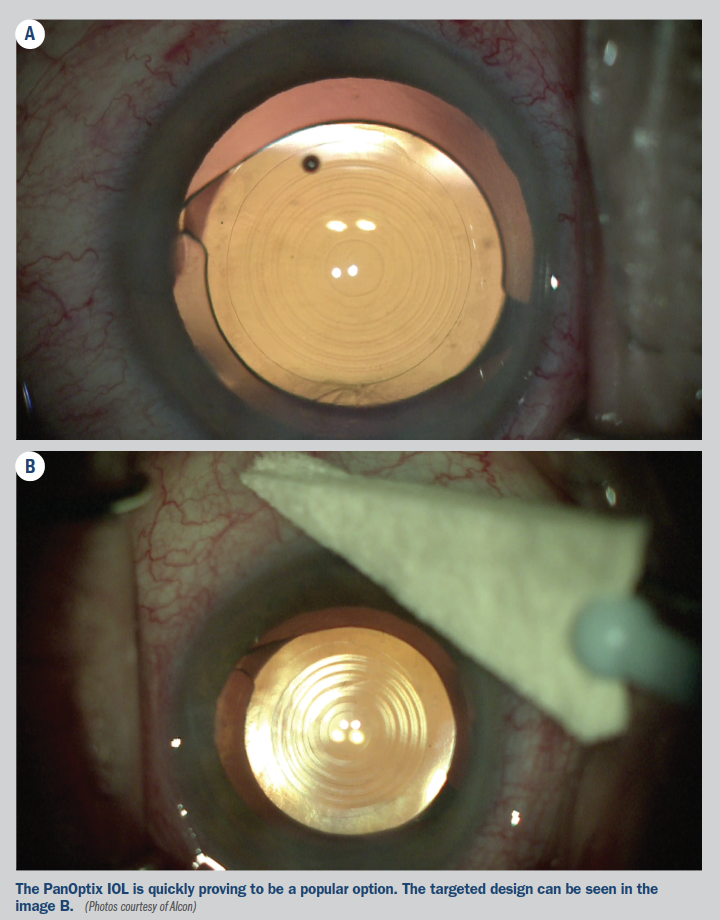
- COVID-19
- Biosimilars
- Cataract Therapeutics
- DME
- Gene Therapy
- Workplace
- Ptosis
- Optic Relief
- Imaging
- Geographic Atrophy
- AMD
- Presbyopia
- Ocular Surface Disease
- Practice Management
- Pediatrics
- Surgery
- Therapeutics
- Optometry
- Retina
- Cataract
- Pharmacy
- IOL
- Dry Eye
- Understanding Antibiotic Resistance
- Refractive
- Cornea
- Glaucoma
- OCT
- Ocular Allergy
- Clinical Diagnosis
- Technology
Trifocal IOL a key for premium cataract surgery practice


The AcrySof IQ PanOptix trifocal IOL delivers a full range of good uncorrected vision, leads to high rates of patient satisfaction, and simplifies surgical counseling and planning.
This article was reviewed by Cathleen M. McCabe, MD
In August, the FDA granted approval for Alcon to market the AcrySof IQ PanOptix trifocal IOL. Surgeons who are using the lens, which is available in spherical and toric versions, agree that it is an important advance in presbyopia-correcting technology.
Cathleen M. McCabe, MD, chief medical officer, Eye Health America, and medical director, The Eye Associates, Bradenton, FL, said she began using the PanOptix IOL as soon as it became available and estimates that she had already implanted it in several hundred eyes within the first six months.
“I think PanOptix is the lens we have been waiting for in the United States,” she said. “With the PanOptix, we can actually meet patient expectations for independence from glasses at all distances.”
Dr. McCabe noted that the patients she has implanted with the PanOptix have been very enthusiastic about their outcomes, and they are sharing their experience with family and friends.
Related: Changing focus of accommodating IOLs now reaching a new level
“Happy and satisfied patients build the market and practices too,” she said. “Although the PanOptix has been available for a relatively short time, I am already seeing patients asking for it through word-of-mouth referral.”
In Canada, ophthalmologists have had access to the PanOptix IOL for more than three years.
Rosa Braga-Mele, MD, MEd, professor of ophthalmology, University of Toronto, Toronto, Ontario, Canada, has been using the lens since it came onto the market in her country and echoed the idea that the lens has benefits for patients and practices.
“Unless we did some mixing and matching or mini-monovision, traditional multifocal IOLs and extended depth of focus (EDOF) IOLs had a weakness at some focal point,” Dr. Braga-Mele said. “In contrast, the PanOptix IOL delivers a blended range of vision with good vision at distance, intermediate, and near without glasses.”
Dr. Braga-Mele noted that with the toric version, ophthalmologists can correct a good range of astigmatism.
“Appropriate patient selection and education are still critical, but given that is done, patients are very, very satisfied with their outcome,” she said. “Happy patients are a source for more patient referrals.”
Related: Performance of trifocal toric IOL highlight in tests
Place in practice
Dr. Braga-Mele said that the PanOptix has become her go-to lens for patients wanting presbyopia correction. It is her lens of choice for patients who in the past she would have offered a bifocal multifocal IOL or an EDOF IOL, and she is offering the PanOptix to a broader pool of patients because of its superior range of vision.
Dr. McCabe pointed out that she has years of experience with various multifocal and accommodating presbyopia-correcting lenses, dating back to the days of the ReZoom and first ReSTOR IOLs.
“I have always tried to find the best solution to match each patient’s needs with the fewest side effects,” she said. “PanOptix is the first lens that gives a useable, functional range of vision.”
With the PanOptix IOL, preoperative counseling conversations with patients have changed for the better. Dr. McCabe observed that in the past she spent a lot of time explaining a variety of options to patients.
“I used to have to say that I could provide technology that would give good uncorrected vision at distance and intermediate and functional vision for near,” she said. “Or, I could offer better near vision with excellent distance vision and ‘okay’ intermediate vision.”
Related: Light-adjustable IOL technology creates novel treatment window
As a third choice, Dr. McCabe said she could try to mix and match technologies to achieve a full range of uncorrected vision.
“It’s a different situation now that I can use one lens that predictably gives excellent vision at distance, intermediate, and near,” she said.
Dr. McCabe also pointed out that in her discussion, she no longer has to distinguish between the intermediate and near focal points or offer surgery with different lenses in fellow eyes.
“I tell patients that I have a lens that will allow them to see up close without glasses and that gives them independence from glasses for their distance vision too,” she noted.
Surgical planning is also easier with the PanOptix because it eliminates mixing and matching and adjusting refractive targets. Both Dr. Braga-Mele and Dr. McCabe say they plan for emmetropia bilaterally when using the PanOptix IOL.
Related: Advanced toric IOL improves refractive outcomes
Reliable refractive outcomes
Dr. McCabe tells patients that 99% of patients in the FDA trial were so satisfied after surgery with the PanOptix IOL that they would want the same lens implanted again. In her practice, the few exceptions involve cases with a small refractive miss, and those can be solved with a touchup procedure.
“We have excellent technology for accurate biometry and advanced formulas for IOL power calculation, including for toricity. Refractive predictability with the PanOptix IOL has been excellent overall,” she said.
Dr. Braga-Mele also observed that the refractive outcomes with the PanOptix IOL are predictable. She attributed its performance, in part, to the fact that it is built on the tried-and-true AcrySof IQ platform.
Related: Accurate data key for planning toric IOL surgery
Although Dr. Braga-Mele said that is almost consistently achieving her target of emmetropia, vision outcomes with the PanOptix IOL seem to have some tolerance to residual sphere and cylinder.
There are some conditions that can impact the results of the IOL.
“Patients seem to do well with this lens if they have up to 0.5 D of hyperopia or myopia and up to 0.6 D of astigmatism,” she observed.
Maintaining awareness of limitations
Because the PanOptix IOL is diffractive technology, some patients can still experience dysphotopsias.
Dr. McCabe says she explains that because the lens has a target-like design, some patients see rings around point sources of light following surgery. She goes on to say that the symptoms are relatively common early after surgery, but by six months, most patients are not bothered by them if they notice them at all.
“I acknowledge that a very small percentage of patients still consider this issue a problem,” Dr. McCabe pointed out. “Then, patients can decide for themselves if this is a potential compromise they are willing to accept for the benefit of having great vision at distance and near.”
Dr. Braga-Mele said that she also discusses dysphotopsias with patients, but that the PanOptix IOL seems to be associated with a little better profile than bifocal lenses when it comes to halo and glare.
Related: Physicians on quest to end dysphotopsias in premium IOLs
Because it splits light to different foci, reduced contrast sensitivity is another issue to consider. Consequently, Dr. Braga-Mele and Dr. McCabe exclude patients as candidates for the lens if they have glaucoma or macular pathology affecting vision now or if there is a real risk for progression.
“If a patient has early diabetic retinopathy, age-related macular degeneration, or glaucoma, I consider the potential for it to worsen over time and reach a level where I think this technology would not have been the best choice,” Dr. McCabe explained. “In that setting, I would not implant the PanOptix IOL or any diffractive presbyopia-correcting lens.”
Optimizing ocular surface
Dr. Braga-Mele and McCabe both emphasized the importance of identifying preexisting dry eye and corneal disease.
“Like all multifocal IOLs, outcomes with the PanOptix are sensitive to the condition of the ocular surface,” Dr McCabe said. “I look carefully for dry eye and treat it preoperatively because dry eye affects the accuracy of surgical planning as well as quality of vision.”
SHE added that some patients may need additional encouragement and more intensive education postoperatively to maintain management for dry eye disease so that the quality of their vision is good.
Related: New techniques probed for managing dry eye disease
Dr. McCabe explained that when patients express some dissatisfaction postoperatively, which is rare, she has found it helpful to ask if they notice fluctuation of their vision and if it seems better sometimes during the day than others.
“If patients report fluctuating vision, I use the information to help them understand why a healthy ocular surface is important for good quality vision,” she said.
Dr. McCabe also noted that she explains that the only thing that fluctuates during the day is the condition of their ocular surface.
“Their observation about fluctuation helps me understand their complaint about their vision and is a sign that if they follow the recommendations for treating their dry eye, their vision will stabilize at its better level,” she said.
Beyond dry eye, Dr. McCabe and Dr. Braga-Mele look for other ocular surface conditions/corneal pathology and determine whether they can be adequately treated preoperatively or are a reason for not recommending any multifocal IOL.
Read more by Cheryl Guttman Krader
Rosa Braga-Mele, MD, MED
p: 416/346-4606
Dr. Braga-Mele is a consultant to Alcon and Johnson & Johnson Surgical Vision.Cathleen M. McCabe, MD
e: ecmccabe13@hotmail.com
Dr. McCabe is a consultant to Alcon, Bausch + Lomb, Johnson & Johnson Surgical Vision, and Carl Zeiss Meditec.
2 Commerce Drive
Cranbury, NJ 08512
All rights reserved.